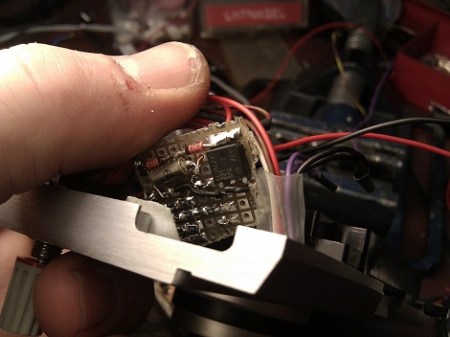
[Georg] wanted to modify his old Polaroid land camera so he could have control over the exposure time. The resulting project is a neat hack, if we say so ourselves.
The stock electronics in Polaroid 100-series Packfilm cameras were a simple analog computer that integrates current through a light-sensitive resistor. This is a simple, low tech way to make sure the exposure time is correct. The usual mod would be to replace photoresistor with a potentiometer, but [Georg] had little success with this modification. After tearing the old hack out of the camera, [Georg] replaced the ancient electronics with a a PIC microcontroller, and is now able to control the shutter in increments down to 1/512th of a second.
Shutter timing is read by a PIC12F629 μC with a BCD encoder. [Georg] kept the shutter magnet setup, and also added a ‘BULB’ routine that holds the shutter open as long as the button is held down. The test photos are quite nice, even if from a 1960s Polaroid Land Camera. Check out the video of [Georg] running though the shutter settings after the break.
[youtube=http://www.youtube.com/watch?v=YlRZHvAusEo&w=470]
















i recently discovered these old packfilm cameras (well discovered fuji still makes the film) and the lack of shutter/exposure control on them is a paaaain.
i ended up buying a (fully manual) polaroid pathfinder 11A and converted it from the defunct rollfilm to packfilm. works great but this is also a great hack. if only it also had electronically controlled aperture and i would so be there.
Very cool. I did not know you could still buy packfilm for these cameras.
It is a good hack. Don’t get me wrong as I love photography, but what would be the reason to use one of these old machines? Just to produce nostalgic looking photos?
Interesting, but my question would be what exactly one needs that for. Don’t you want to just expose right? There is no immidiate and free view of the image, takes a minute and costs money. I would rather like to have that right instead of just reproducible.
@ veneficus
If the only goal of photography was to reproduce reality then yes, I can see how there would be no point. But photography is an art form too so that means each kind of camera can be used in a way that takes advantage of their intrinsic traits.
You can do a lot of cool things with instant film and there is no immediate photoshop or digital process that’s equivalent to it.
@ Steve
There isn’t any sort of comprehensive zone metering on cameras like that. All they used was a photoresistor that made use of general light levels.
Sometimes it’s better to do it manually as opposed to letting the light meter do it. Plus, “right” exposure is subjective. You may want to highlight a particular feature through your metering or really change the parameters of your exposure to produce some artful effect.
The camera being hacked was fully automatic. So you wouldn’t be able to do anything with it really.
@steve; “Don’t you want to just expose right?”
of course you do, but an experienced eye and/or a handheld meter is far more accurate than the extremely coarse approximation of a simple analog electric eye device from the 1960’s.
for that matter, it is often still more accurate than modern professional digital cameras metering algorithms are, which is why today a manual mode is present still on even the most expensive current cameras. auto mode is pretty good nowadays, but a computer AI still can’t think, nor do exception handling better than an experienced human.
If you’ve ever used one of the automatic cameras you’d know that the automatic exposure is rather iffy, you always end up with bad shadows or highlights. It’s basically just a photo-resistor that closes the shutter when enough light hits it.
There are manual Polaroid models like the 180/185/195 and the 600SE but they are rare and rather expensive, this design for a proper manual shutter is most welcome.
I think the code needs a bit more maybe, the shutter on the pack film cameras was capable of up to 1/1200th speed and this only goes up to 1/500th, probably because it only has 9 shutter positions on the dial. Also the bulb mode should be so it opens the shutter the first time you press the button, then closes it when you press it again, this would save having to hunt down a rare and expensive Polaroid only cable release.
Also wonder if it can be used on the 3 volt battery models as well.
Ok, I’ll buy that. Makes perfectly sense. A possible extension would include a exposure meter connected to the microcontroller and on the camera… Could be done with a cellphone camera-chip.
Not sure why you’d hook an exposure meter to it, any cheap old handheld meter (selenium or CdS) can meter a scene better than the Polaroid auto sensor, so it’s just easier to read the meter and set it yourself.
I just noticed that with the shutter now separated from the original Polaroid circuitry the film speed and scene selector switches (if you have a model with them) can now be used on all film speeds giving a greater range of apertures.
Wonder if you could find a way tell which film speed/scene combo is selected and relay it to the PIC (need a PIC with more I/O ports?), and then make a row of 6 flat LED’s with labels in the top of the shutter housing to display the aperture selected.
Times like this i wish i understood circuits instead of code.
Awesome work! :D :D :D
If anyone is still interested in this project the files are here now:
http://www.sx2pc.com/shutterpic/index.html
– Georg